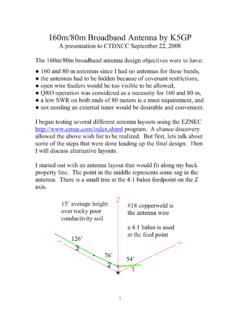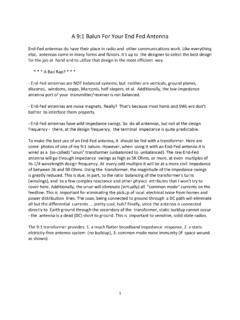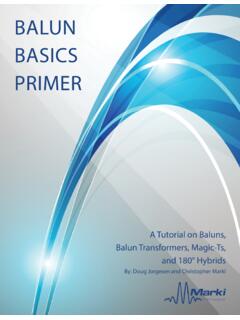Transcription of 33ft Verticals and 4:1 Ununs - MARTIN - G8JNJ
1 33ft Verticals and 4:1 Ununs Following a discussion on eham relating to the use of 4:1 Unun s for multiband operation in conjunction with 33ft vertical antennas. I referred to measurements I had previously made with 10m vertical antennas fed with 4:1 Ununs . Most of this work was done as part of an investigation into the performance of the Comet CHA-250 broadband antenna, which uses a deliberately lossy 6:1 Unun to provide a good match on all bands. As part of this investigation I discovered that the Comet antenna actually worked better than I would have expected it to. In some cases it produced similar results than those obtained with a vertical fed via a 4:1 Unun at the base of the antenna and fed with coax from an atu-tuner in the shack.
2 Some comparison graphs can be found here. As you would guess there is a large degree of interaction between the Unun and the impedance presented to it, especially when it is being used as a multiband antenna. The two main problems are major copper losses when feeding a vertical which is electrically too short (due to the very low resistive component presented to the Unun by the radiating element), unwanted resonances when feeding highly reactive impedances and loss in the transformer core due to too low a value of shunt impedance when presented with a very high secondary impedance. Perhaps surprisingly the Ununs with the lowest losses are not always the best type to use in this application.
3 This may seem odd, but high Q designs using Type 2 powdered iron cores tend to interact badly with some of the impedances that can be encountered at the base of the vertical radiator at specific frequencies. This interaction causes very high excursions of impedance which present an even worse match to the 50 ohm coax feed than would otherwise be present. Lower Q materials can help damp these excursions to manageable proportions. However it s not a good idea to overdo this, a balance has to be achieved. In some cases a 4:1 Unun (or balun ) doesn t actually improve the match, or widen the matching range of a tuner. It s just the additional loss masking the poor match. A 6dB attenuator in the feed line will allow you to achieve better than 2:1 VSWR on any band, but the match at the other end will still be bad.
4 See this graph showing the VSWR of several different 4:1 Ununs connected to a vertical. When required, I use a 4:1 Unun which I have specially optimised for this application, it is lossy but the improvement in match to 50 ohms offsets the mismatch loss which would otherwise occur along the feedline. Using a 4:1 balun and remote coax fed tuner typically adds about to 2dB of loss in the best case, compared to a coax fed ATU at the base of the antenna with no Unun. In the worst case with a bad set of parameters you can lose 10dB or more. The bottom line is that you have to treat the antenna system as a whole in order to minimise losses. Incidentally if you want or 'see' copper losses in an atu feeding low impedance load, take a look at the thermal images towards the bottom of this page.
5 My experience is that most atu losses occur when trying to match to low impedance capacitive loads, usually when using short Verticals on the LF bands. Big external coils can help to improve this situation so that the atu doesn't have to work so hard. If you take a look at this graph It shows field strength measurements I made some time ago, which compare a 30ft vertical fed with an auto-tuner at the base vs. the same antenna fed a 4:1 balun wound with 75 ohm coax on two separate type 43 ferrite cores and a remotely sited tuner fed via 200ft of low loss LDF2-50 coax vs. a broadband antenna of the same element length. To summarise the results WRT to reference antenna consisting of 30ft wire vertical fed with auto-tuner at base.
6 The 4:1 balun and coax fed remote tuner and also the broadband antenna Ununs produced signal levels about 20dB down on 160m, 6dB down on 80m and an average of about 3db down with dips of > 6dB on 40m through to 10m. Obviously these parameters will change with differing designs of balun , length coax and vertical radiator, but it gives a good ballpark indication of the relative performance of each type. As a result of these earlier investigations I was prompted to spend further time making comparisons between different methods of feeding a 33ft vertical wire. I wished to ensure that the previous measurements were still valid. I was particularly concerned that the radial system I used for the first set of tests may not have been good enough, and that the additional earth loss would have influenced the results to favour the lossy broadband Ununs .
7 As before, measurements were made using a remote controlled Icom PCR-1000 receiver fed from a Datong Active antenna. This was vertically polarised and mounted at approx. 20m (66ft) AGL. The distance between TX and Rx site was approx. (2miles). For the 4:1 Unun, I chose to use 13 bifilar turns on a T200A-2 core configured as a Ruthroff voltage Unun. There are a number of problems associated with the use of iron power cores for this application, take a look at this document In this case I decided to use them for the test in order to emulate a commonly chosen design. The main problem is not always associated with the choice of core material; it's the coax mismatch loss, especially when the resistive component of the antenna impedance is very low.
8 Adding a 4:1 balun into the equation makes things even worse. In the past I have used other core materials for Unun's which have been used to feed vertical antennas, including type 61, 31 and 43 but it doesn't make much difference to the overall performance. You improve the results on some frequencies, but loose it on others, sometimes by 2 or 3dB either way. A lot depends upon the interaction with the rest of the system. To put this into perspective, I find that day to day changes in the weather and propagation conditions can make +/- 1dB or so difference in measurements over the 2 mile path measurement path. When I perform these measurement runs, I try to complete them all within an hour and usually repeat the first tests a second time at the end of the runs as an overall confidence check.
9 As I stated before the main source of system losses is the mismatch between antenna feed impedance, Unun and coax at the low frequencies. This is predicted by graphs on Cebik and Owen VK1OD's websites. For these tests as a reference point, I used a CG-3000 auto-tuner at the base of the wire (typically 1dB loss through the tuner when presented with moderate load impedances), which was fed against 10 random length buried radials. The antenna wire was 2mm tinned copper with PVC insulation suspended via a rope from a tree branch and spaced approx. 1m (3ft) away from the trunk. The wire was resonant on with a measured Rs value of approximately 55 Ohms. The field strength on with no tuner connected was exactly the same as with the tuner in circuit.
10 I could not determine any difference between the two. All measurements were made using the same wire in exactly the same position for each test run. For the series of tests the 33ft wire was fed at the base with a copy of the broadband Comet CHA-250 Unun, my improved version of the Comet the G8 JNJ 5:1 Unun and finally a 4:1 Unun fed with an auto-tuner at the far end of the 62m (200ft) LDF2-50 coax feed cable. The tuner was connected directly to the transceiver, and all cables were kept the same during the series of tests. If the tuner was connected directly to the 4:1 Unun at the base of the antenna wire, I would expect it to be within a fraction of a dB of the auto-tuner.



